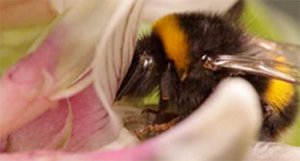 Full
FullGuide »
Field beans benefit from the activity of pollinating insects, setting seed by a combination of a) cross- pollination by bees, b) self-pollination facilitated by bees, c) spontaneous self-pollination without bees. The proportion of seed produced by each mode of pollination can vary with variety, level of cross- pollination in the previous generation, and with stress or disease.
Pollination by bumblebees increases yield of Wizard beans by around 15% under normal conditions compared to plants receiving no pollination. Quantified yield benefits in other varieties range from 17 to 30%, and can rise to over 50% when crops are affected by heat stress. Yields of bee-pollinated plants can also be 20% less variable, and plants can have greater harvest index, shorter straw, and earlier ripening. It is unclear whether insect pollination changes seed size, and there is no evidence that it affects protein content.

The most common pollinator of beans is the Buff- tailed bumblebee Bombus terrestris. This pollinator is less effective than specialised long-tongued bumblebees, but more effective than honeybees. Many bees rob nectar from the back of bean flowers - this still improves pod set relative to no visitation.
Care must be taken regarding application of insecticides immediately before or during crop flowering.
Crop pollination by wild bees can be increased using floral and grass field margins. Floral margins can attract more pollinators of different types, and provide food and nesting resources through the season to maintain populations when crops are not in flower. Six years of experimentation in Buckinghamshire showed that converting 3 % (e.g. ELS) or 8% of land at field edges to natural habitat, mainly long grass for bee nesting, increased overall bean yield by 25% and 35% respectively compared to business as usual.
Text and image on this page from Dr Jake Bishop, University of Reading